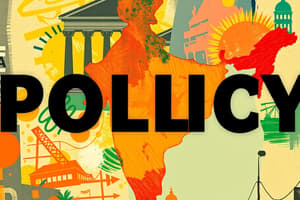Podcast
Questions and Answers
What is the estimated GDP growth rate for India in FY23?
What is the estimated GDP growth rate for India in FY23?
- 11.5%
- 3.36 trillion
- 7.5%
- 6.5% (correct)
Which sector characterizes India's mixed economy?
Which sector characterizes India's mixed economy?
- Growing private sector only
- Large public sector only
- Agriculture only
- Large public sector, agriculture, and small and medium-sized industries (correct)
Who manages the fiscal policy in India?
Who manages the fiscal policy in India?
- Reserve Bank of India (RBI) only
- Ministry of Finance and the Reserve Bank of India (RBI) (correct)
- Indian government
- Ministry of Agriculture
What is the purpose of the Pradhan Mantri Garib Kalyan Anna Yojana (PM-GKAY) in India?
What is the purpose of the Pradhan Mantri Garib Kalyan Anna Yojana (PM-GKAY) in India?
What is the purpose of the Pradhan Mantri Awas Yojana Urban (PMAY-U)?
What is the purpose of the Pradhan Mantri Awas Yojana Urban (PMAY-U)?
What is a major concern regarding the Indian economy?
What is a major concern regarding the Indian economy?
What sector is facing slow growth in India's GDP?
What sector is facing slow growth in India's GDP?
What role does RBI play in fiscal policy?
What role does RBI play in fiscal policy?
Which factor tends to lead to higher GDP per capita in states like Punjab and Haryana?
Which factor tends to lead to higher GDP per capita in states like Punjab and Haryana?
What plays a crucial role in determining the GDP per capita of states like Kerala and Tamil Nadu?
What plays a crucial role in determining the GDP per capita of states like Kerala and Tamil Nadu?
Which states tend to have higher GDP per capita due to better industrial development?
Which states tend to have higher GDP per capita due to better industrial development?
What is expected to happen to the GDP per capita as India continues to grow and develop?
What is expected to happen to the GDP per capita as India continues to grow and develop?
What was India's GDP per capita in 2022?
What was India's GDP per capita in 2022?
Which state in India had the lowest GDP per capita according to the text?
Which state in India had the lowest GDP per capita according to the text?
What contributes to higher GDP per capita in states like Maharashtra and Gujarat?
What contributes to higher GDP per capita in states like Maharashtra and Gujarat?
Which sector characterizes India's diverse economy according to the text?
Which sector characterizes India's diverse economy according to the text?
Flashcards are hidden until you start studying
Study Notes
Indian Economy: An Overview
The Indian economy is one of the fastest-growing economies in the world, with a nominal Gross Domestic Product (GDP) of $3.36 trillion in 2023. The country has a mixed economy, characterized by a large public sector, agriculture, and small and medium-sized industries, along with a growing private sector. India's economy is the world's sixth-largest by nominal GDP and the third-largest by purchasing power parity.
Gross Domestic Product (GDP)
India's GDP is estimated to grow at 6.5% in FY23, down from 11.5% in FY22, reflecting the impact of the pandemic on the economy. The country's GDP has been growing steadily over the years, with an average annual growth rate of 7.5% from 2017 to 2023.
Fiscal Policy
Fiscal policy is a tool used by the government to influence economic activity by changing the level of taxation and public spending. In India, the fiscal policy is managed by the Ministry of Finance and the Reserve Bank of India (RBI). The government of India uses fiscal policy to control inflation, stabilize the economy, and maintain a stable currency.
The Indian government has implemented several fiscal measures to support the economy during the COVID-19 pandemic. These measures include:
- The Atmanirbhar Bharat Abhiyan (Self-Reliant India Mission) to stimulate demand and supply in the economy.
- The Pradhan Mantri Garib Kalyan Anna Yojana (PM-GKAY) to increase the purchasing power of the poor.
- The Pradhan Mantri Awas Yojana Urban (PMAY-U) to provide affordable housing to the urban population.
- The Pradhan Mantri Garib Kalyan Rojgar Abhiyaan (PM-GKRA) to generate employment in rural areas.
The RBI also plays a crucial role in fiscal policy by setting interest rates and managing the money supply. The RBI has reduced the policy rate by 110 basis points to 4.40% to support the economy during the pandemic.
Challenges and Concerns
Despite the positive growth rate, the Indian economy faces several challenges and concerns, including:
- High inflation rate: India's inflation rate was 7.27% in 2022, which is above the RBI's inflation target of 4%.
- High fiscal deficit: The country's fiscal deficit was 6.9% of GDP in 2022, which is above the RBI's recommended limit of 3%.
- Slow growth in manufacturing: The manufacturing sector, which accounts for 17% of India's GDP, is growing at a slow pace due to factors such as labor laws, red tape, and a lack of infrastructure.
Conclusion
The Indian economy is a large and diverse economy, with a mix of traditional and modern industries. The government and the RBI use fiscal policy to influence economic activity and maintain a stable currency. The country faces several challenges, including high inflation and fiscal deficit, which need to be addressed to sustain the growth momentum.
Studying That Suits You
Use AI to generate personalized quizzes and flashcards to suit your learning preferences.




